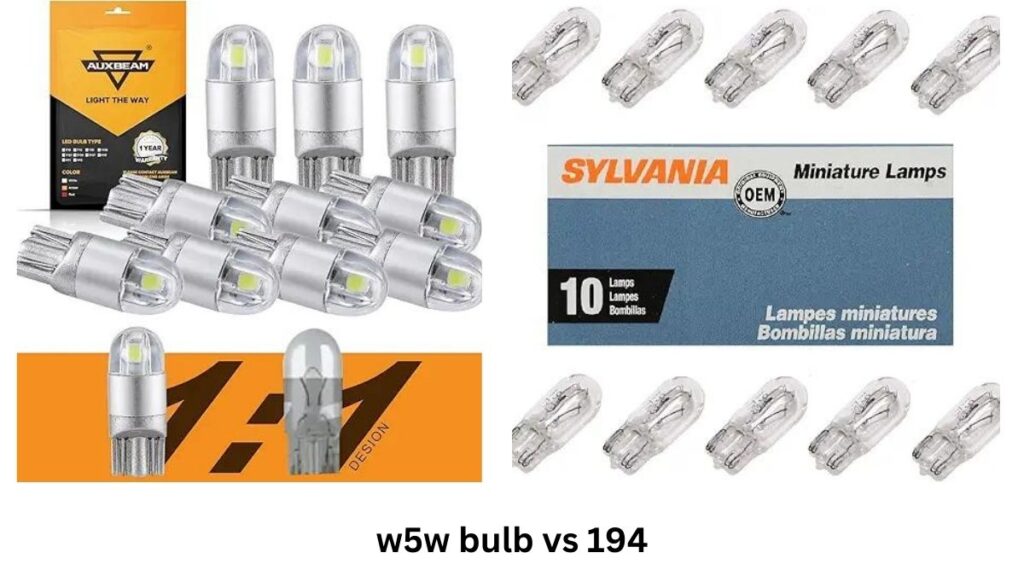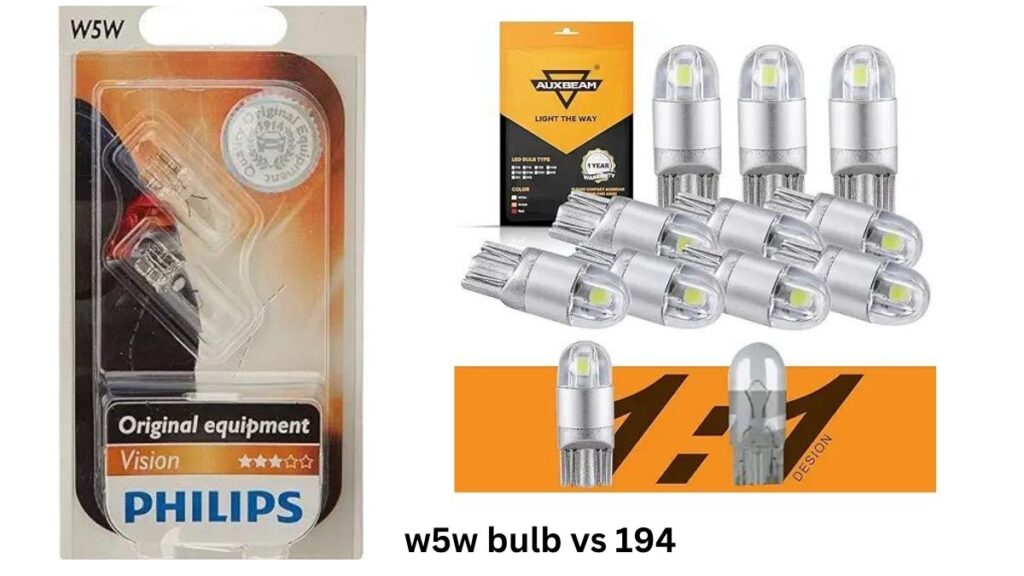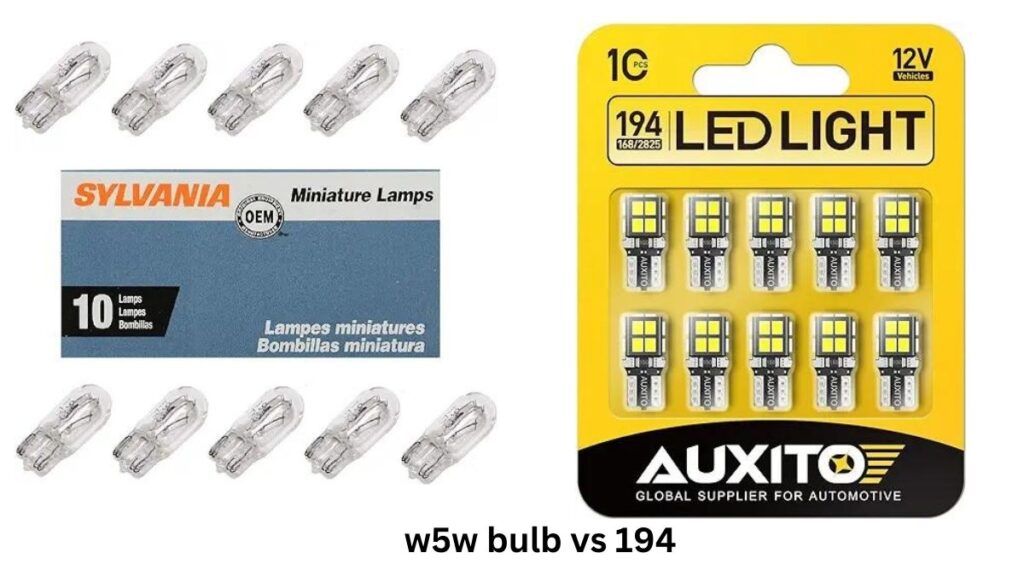Have you ever found yourself squinting at tiny bulb numbers, wondering if you’re about to buy the right replacement for your car? You’re not alone! The world of automotive lighting can be as confusing as a pitch-black country road. Today, we’re shining a light on two popular contenders: the w5w bulb vs 194 bulbs. Did you know that choosing the wrong bulb type can not only affect your visibility but also your car’s electrical system? Let’s dive into the illuminating world of these tiny but mighty lights and help you make the brightest choice for your ride!
What Are w5w bulb vs 194 bulb?
1. W5W Bulbs
W5W bulbs are small wedge-shaped bulbs commonly used in cars for various applications such as parking lights, license plate lights, and interior lighting. Their compact size and versatile nature make them a popular choice in many modern vehicles. W5W bulbs operate at a 12V voltage and produce a power output of 5 watts. The “W” stands for watts, while the “5” indicates the power consumption.
2. 194 Bulbs
On the other hand, 194 bulbs are also wedge-based bulbs, often found in interior lighting, license plate lights, and dashboard illumination. These bulbs are slightly larger than W5W bulbs and are widely used in older vehicle models. They typically have a voltage of 12V and a power output of around 3.8 watts. Despite their smaller wattage, they offer reliable brightness for various automotive purposes.
Key Differences Between W5W and 194 Bulbs
Choosing between w5w bulb vs 194 can be tricky because they seem so similar. However, key differences can help you decide which one fits your car’s needs best.
i). Physical Dimensions and Base Types
Both W5W and 194 bulbs feature a wedge base, but they differ slightly in size. W5W bulbs have a thinner and more compact design, while 194 bulbs are a bit bulkier. This difference can affect how well they fit in certain lighting fixtures, making it essential to check compatibility with your vehicle.
ii). Voltage and Wattage Specifications
W5W bulbs run at 12 volts with a power output of 5 watts, while 194 bulbs also use 12 volts but produce only about 3.8 watts. While W5W bulbs consume slightly more power, they tend to deliver better brightness, especially in exterior applications like parking lights.
iii). Light Output and Color Temperature
Both bulbs offer similar light output in terms of brightness, but W5W bulbs tend to have a cooler white light, while 194 bulbs often emit a warmer tone. Color temperature preferences can impact how the light looks at night, with cooler lights providing better clarity.
iv). Lifespan and Durability
When it comes to longevity, W5W bulbs tend to have a longer lifespan due to their slightly higher wattage and improved durability. 194 bulbs, while reliable, may need to be replaced more frequently, especially in harsher weather conditions.

Common Applications in Vehicles
a). W5W Bulbs in Cars
W5W bulbs are often found in parking lights, license plate lights, interior dome lights, and side marker lights. These bulbs are versatile and commonly used in modern vehicles for areas that require bright, low-energy lighting.
b). 194 Bulbs in Vehicles
194 bulbs are typically used in older car models, but they’re still prevalent in dashboard lighting, glove box lights, and trunk illumination. These bulbs are slightly larger, making them more suited for interior applications where size is less of an issue.
c). Interchangeability
In some cases, w5w bulb vs 194 can be used interchangeably, especially for applications like license plate lights. However, checking your vehicle’s manual or consulting a professional is recommended to ensure the right fit.
Pros and Cons of W5W Bulbs
Pros of W5W Bulbs
1. Brighter Light Output: W5W bulbs tend to provide a cooler, brighter light, making them ideal for parking lights and other exterior uses.
2. Durability: These bulbs are built to last longer, reducing the frequency of replacements.
3. Energy Efficiency: Despite their bright light, they consume relatively low power, helping to conserve energy in your vehicle.
Cons of W5W Bulbs
1. Slightly Higher Power Consumption: W5W bulbs use more power than 194 bulbs, which could be a concern in vehicles with older electrical systems.
2. Cost: They may be slightly more expensive than 194 bulbs due to their increased brightness and longevity.
Pros and Cons of 194 Bulbs
Pros of 194 Bulbs
1. Cost-Effective: 194 bulbs are typically less expensive than W5W bulbs, making them a budget-friendly option for car owners.
2. Widely Available: These bulbs are still commonly found in many vehicles and can be easily sourced.
3. Warm Light Output: The warmer color temperature can be more pleasing in interior lighting applications.
Cons of 194 Bulbs
1. Shorter Lifespan: 194 bulbs generally don’t last as long as W5W bulbs, especially in exterior applications.
2. Less Brightness: While they are adequate for interior lighting, 194 bulbs may not provide enough brightness for exterior uses like parking lights.
Installation and Replacement Guide
Replacing W5W and 194 bulbs is a relatively simple task that can be done at home. However, it’s important to follow proper procedures to ensure a safe and effective installation.
Step-by-Step Process for Replacing W5W Bulbs
1. Turn off the vehicle and locate the bulb that needs replacing.
2. Use a screwdriver or your fingers to remove the bulb cover.
3. Carefully pull the old W5W bulb from the socket.
4. Insert the new W5W bulb, making sure it’s securely fitted.
5. Replace the bulb cover and test the lights.
How to Safely Install 194 Bulbs
1. Turn off the vehicle’s power and open the bulb compartment.
2. Gently remove the old 194 bulb from its socket.
3. Insert the new bulb, ensuring it fits snugly.
4. Close the compartment and test the new bulb to confirm proper installation.

LED Alternatives: The Future of Automotive Lighting?
With the increasing popularity of LED lighting, many car owners are switching to LED versions of W5W and 194 bulbs. Here’s why:
Benefits of Upgrading to LED
1. Brighter and Clearer Light: LED bulbs offer superior brightness and clarity compared to traditional halogen bulbs.
2. Energy Efficiency: LEDs consume less power, reducing strain on your vehicle’s electrical system.
3. Longer Lifespan: LED bulbs can last up to 10 times longer than halogen bulbs, saving you money in the long run.
Potential Challenges
1. Higher Cost: LED bulbs tend to be more expensive upfront.
2. Compatibility Issues: Not all vehicles are compatible with LED bulbs, so it’s important to check before making the switch.
Making the Right Choice for Your Vehicle
When deciding between w5w bulb vs 194, there are several factors to consider:
1. Vehicle Compatibility: Check your vehicle’s manual to determine which bulb type is recommended.
2. Application: Consider where the bulb will be used—W5W bulbs are better suited for exterior applications, while 194 bulbs excel in interior lighting.
3. Brightness: If you need a brighter light, W5W bulbs are the better option, but for softer interior lighting, 194 bulbs work just fine.
Conclusion: w5w bulb vs 194
Alright, fellow car enthusiasts, we’ve navigated the twists and turns of the w5w bulb vs 194 bulb debate! Remember, the best choice ultimately depends on your specific vehicle and lighting needs. Whether you’re team W5W or rooting for the 194, both these little luminaries have their place in the automotive world. Don’t forget to check your car’s manual or consult with a professional if you’re still unsure. After all, the right bulb can make all the difference between a dim drive and a brilliant journey. So, are you ready to light up the road ahead? Your car’s perfect bulb is waiting to shine!
Related articles:


